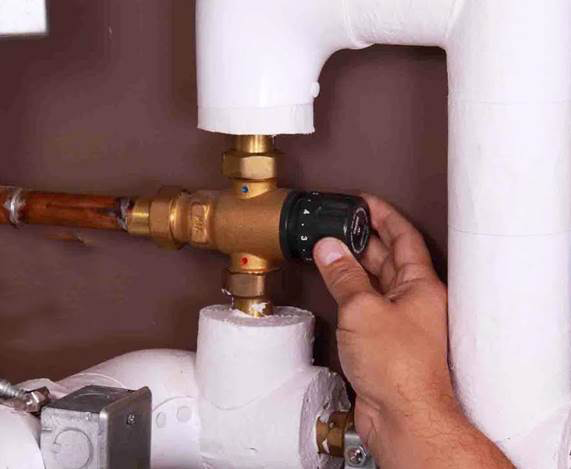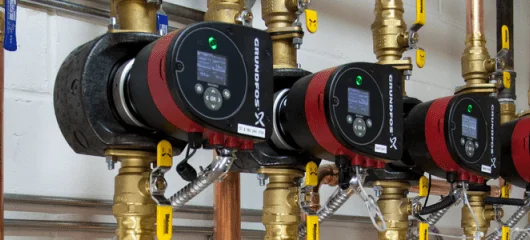For a simple domestic hot water application, with a point-of-distribution mixing valve (ASSE 1017 certified) such as the Caleffi 521 Series mounted near the water heater, check valves are typically not needed unless required by local code or the local authority. That being said, check valves will prevent migration of hot water into the cold line, and vice versa, when there are pressure fluctuations in the system (such as a flushing toilet). Checks will prevent thermal siphoning during periods of non-consumption.
For a point-of-use mixing valve (ASSE 1070), checks are a requirement; all Caleffi 5213 Series anti-scald valves come with checks.








I always install flow restrictors when installing mixing valves on internal tankless coils on boilers.
I notice a lot of techs don't install them with anti scald valves. Are they needed to keep from running out of hot water.
Thanks in advance,
Denny
Any piping restriction will reduce flow rate to the fixtures (which may or may not be OK for the user) and yes that will reduce hot water consumption rate at the boiler. New low-flow fixtures shouldn't need additional restrictors inline. As long as the boiler has enough capacity to satisfy demand, additional restrictors should be unnecessary. And the point-of-use (anti-scald) mixing valves (which always have check valves) will deliver the proper temperature water, whether or not there is an upstream restrictor, as long as flow is not below the minimum flow rate of the valve.
I did not know that there were check valves that make sure that the hot and cold water lines don't mix. Also a mixing valve seems like a great way to make sure that when I am showering and someone is using the bathroom that the water doesn't get hotter or colder. I believe that paying a small amount for something that can help to prevent a bigger problem is always a great thing to do and is always worth it. http://monumentalsupply.com/supplies/valves
how is the TMV COUPLER CHECK VALVE removed if needed?
The check valves installed inside the tailpiece are not designed to be removed and reinstalled. If you need to remove them you would have to pull out the unit out of the tail piece which would damage the check valve. You would need to order and install a new replacement chjeck valve.
How do you remove the check valve after you installed them? I forgot to put the o ring in before I installed them and I’ve been trying to pull them out but I can’t
John, The check valves are a one time use. Once they are installed into the tailpiece they cannot be removed without damaging them. I am sorry to hear you forgot the 0-ring. The only option would be to pull the check valves out and replace them. They will not come out to be reinstalled.
I have a weird problem occurring at a property. The house has a newer gas hot water heater and all of the bathrooms are renovated. The house has copper piping except in the recently renovated bathrooms. The issue occurs only in the shower. During the shower, the hot water slowly diminishes and remains that way. The only way to increase the temperature is to turn on the hot water at the bathroom sink. When the sink is on the shower temperature then gets hot again. I don’t see a TMV at the hot water heater. Could a TMV fix this problem? If not, do you know what can rectify this?
In reply to I have a weird problem by Sean Hebbon
Sean, If you do not have a mixing valve in place, adding one may not correct this issue. You could have an issue with the shower valve. I would contact a local plumber to evaluate and provide solutions.
In reply to Sean, If you do not have a by dan_firkus
Oh how I wish the solution was that simple. We started with the shower valves - all 3 of them. Those were adjusted and checked for any clogging. Two of them are Moen and one is a Delta. They are all fine. We have also checked for crossed lines since the pipes in the basement were currently exposed heading to the bathrooms. Everything seems to be fine. That’s why I’m thinking the problem could be occurring right out of the heater.
In reply to Oh how I wish the solution by Sean Hebbon
Sean, It could source temperature or pressure to the mixing valve. If you could email photos of the installation to techsupport.us@caleffi.com or call into tech support at 414-238-2360 we would be happy to discuss and work towards a resolution.